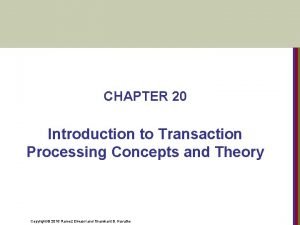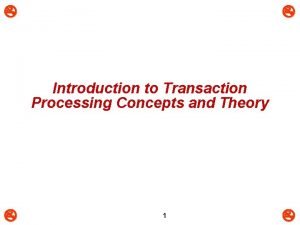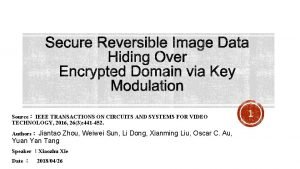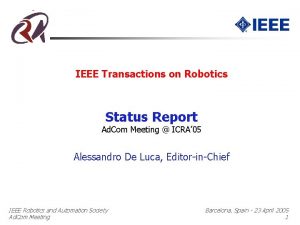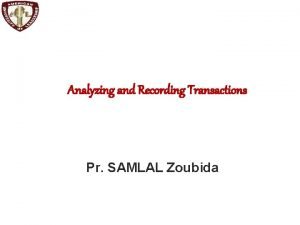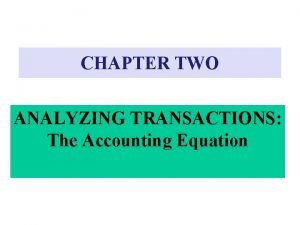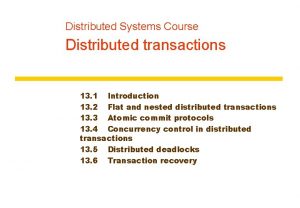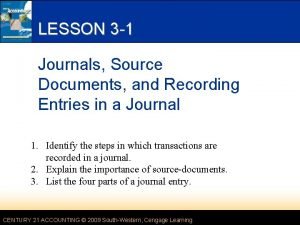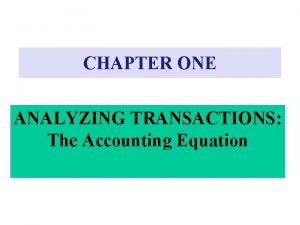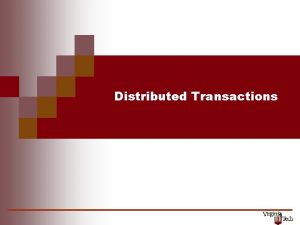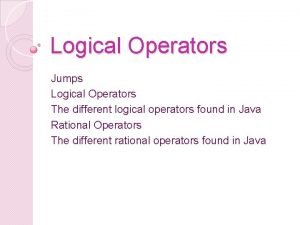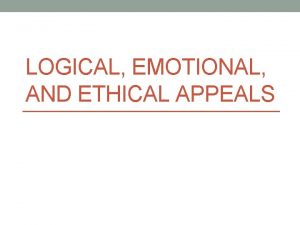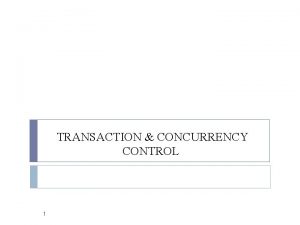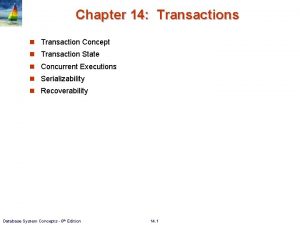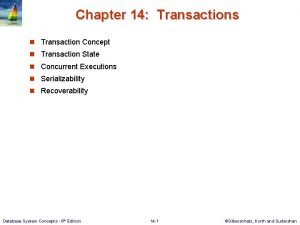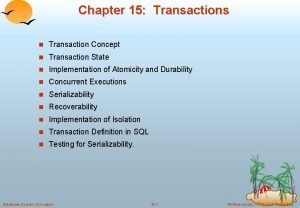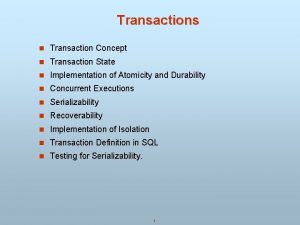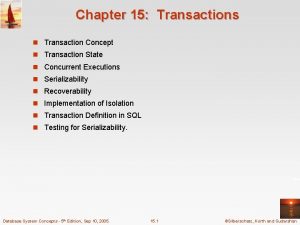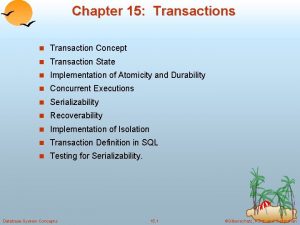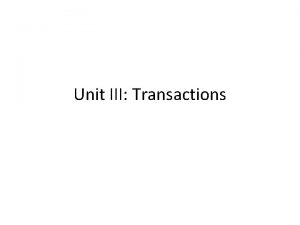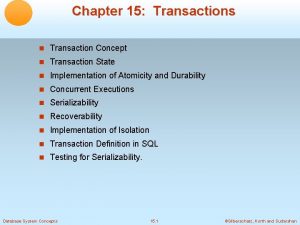Transactions Transaction Concepts A transaction is a logical






















- Slides: 22

Transactions

Transaction Concepts • • A transaction is a logical unit of work. It begins with the execution of a Begin Transaction operation, and ends with the execution of a commit or rollback operation. A sample transaction BEGIN TRANSACTION : Update acc 123 { BALANCE : = BALANCE – 100}; IF any error occurred Then Go to UNDO; END IF Update acc 456 { BALANCE : = BALANCE + 100}; IF any error occurred THEN GOTO UNDO; END IF; COMMIT; / * Successful termination */ GO TO FINISH; UNDO : ROLLBACK; / * Unsuccessful termination */ FINISH : RETURN; The Commit operation signals successful end-of transaction. The ROLLBACK operation signals unsuccessful end-of transaction. [ something wrong ]

Example • Transaction to transfer Rs 50 from account a to account B Read (A) A : = A-50 Write (A) Read (B) B: =B+50 Write (B)

Program initiation

State transaction diagram

• Active – The initial state. The transaction stays in this state while it is executing • Partially committed – After the final statement has been executed • Failed – After the discovery that normal execution has no longer proceed (Failed transaction) • Aborted – After the transaction has been, rolled back, the database has been restored to its state prior to the start of the transaction. • Committed – After successful completion.

Transaction Recovery

Transaction Recovery • A transaction begins by executing a BEGIN TRANSACTION operation and ends by executing either a COMMIT or a ROLLBACK operation. • Commit establishes a commit point. A commit point thus corresponds to the (successful) end of a logical unit of work, and hence to a point at which the database is supposed to be in a correct state. • ROLL-BACK, by contrast, rolls the database back to the state it was in at BEGIN TRANSACTION, which effectively means back to the previous commit point. [ or first transaction in the program]

ACID Properties • Atomicity – Transactions are atomic (all or nothing) • Correctness (Consistency) – Transactions transform a correct state of the database into another correct state, without necessarily preserving correctness at all intermediate points. • Isolation – Transactions are isolated from one another. That is, even though in general there will be many transactions running concurrently, any given transaction’s updates are concealed from all the rest, until that transaction commits. – Another way of saying the same thing is that, for any two distinct transactions A and B, a might see B’s updates (after B has committed) or B might See A’s updates (after A has committed), but not both. • Durability – Once a transaction commits, its updates persist in the database, even if there is a subsequent system crash.

Types of failures • Transaction • System • Media

Several reason for transaction to fail in the middle of execution • A computer failure (system crash) – Hardware, software or network failure. • A transaction or system error – Integer overflow or division by zero, logical program error • Local errors or execution conditions detected by the transaction – Notice the exception condition, such as insufficient account balance in a banking, may cause a transaction, such as find withdrawal to be cancelled. • Concurrency control environment – Several transactions are in a state of deadlock. • Disk failure – Disk read/write error • Physical problems and catastrophes – Power failure, conditioning failure, etc

SQL Facilities Transaction Control Language Commit, Rollback, Savepoint • The TCL statements give you flexibility to undo transactions or write transactions to the disk • Transactions provide consistency in case of a system failure.

• Commit Current transaction and writes all changes permanent to the disk. • Savepoint Marks a point in the current transaction • Rollback to [savepoint n] – Undoing all changes – if n to savepoint undo the n position

Example SQL> insert into emp values ( &empno, &ename, &salary, &dno, &comm); SQL>/ (input some record) SQL> select * from emp; SQL> Commit; SQL> Delete from emp where comm>=2500; SQL> Select * from emp; SQL> Rollback; SQL> Select * from emp; SQL> Savepoint x; SQL> delete from emp where dno=10; SQL> Roolback to x;

System Recovery

System Recovery • The system must be prepared to recover, not only from purely local failures such as an overflow exception within an individual transaction, but also from “global” failures such as a power outage. • Local failure, by definition, affects only the transaction in which the failure has actually occurred. • A global failure, by contrast, affects all of the transactions in progress at the time of the failure and hence has significant system wide implications

Two categories • System failures – Which affect all transactions currently in progress but do not physically damage the database. A system failure is sometimes called a soft crash. • Media failures – Which do cause damage to the database or some portion thereof, and at least those transactions currently using that portion. A media failure is sometimes called a hard crash.

• A system failure has occurred at time tf. • The most recent checkpoint prior to time tf was taken at time tc.

• Transaction of type T 1 completed (successfully) prior to time tc. • Transactions of type T 2 started prior to time tc and completed (successfully) after time tc and before time tf. • Transactions of type T 3 also started prior to time tc but did not complete by time tf. • Transactions of type T 4 started after time tc and completed (successfully) before time tf. • Finally, transactions of type T 5 also started after time tc but did not complete by time tf.

It should be clear that when the system is restarted, transactions of types T 3 and T 5 must be undone, and transactions of types T 2 and T 4 must be redone. Note however, that transactions of type T 1 do not enter into the restart process at all because their updates were forced to the database at time tc as part of the did point process. Note too that transactions that completed unsuccessfully (ie. , with a rollback) before time tf also do not enter into the restart process at all.

1. Start with two lists of transactions, the UNDO list and the REDO list. 2. Set the UNDO list equal to the list of all transactions given in the most checkpoint record and the REDO list to empty. 3. Search forward through the log, starting from the checkpoint record. 4. If a BEGIN TRANSACTION log record is found for transaction T, add T the UNDO list. 5. If a COMMIT log record is found for transaction T, move T from the list to the REDO list. 6. When the end of the log is reached, the UNDO and REDO lists identify, lively, transactions of types T 3 and T 5 and transactions of types T 2 and T 4.

• Restoring the database to a correct state by redoing work is sometimes called forward recovery. • Similarly, restoring it to a correct state by undoing work is sometimes called backward recovery.
 Logical equivalence
Logical equivalence Kesetaraan logis adalah
Kesetaraan logis adalah Introduction to transaction processing concepts and theory
Introduction to transaction processing concepts and theory Introduction to transaction processing concepts and theory
Introduction to transaction processing concepts and theory General journal example
General journal example Which sequence correctly summarizes the accounting process?
Which sequence correctly summarizes the accounting process? Remote side-channel attacks on anonymous transactions
Remote side-channel attacks on anonymous transactions Transactions on circuits and systems
Transactions on circuits and systems Ieee transactions on robotics impact factor
Ieee transactions on robotics impact factor Supermarket transactions.xlsx
Supermarket transactions.xlsx Analyzing and recording transactions
Analyzing and recording transactions Analyzing transactions example
Analyzing transactions example What is a source document
What is a source document Analyzing transactions
Analyzing transactions Assets increase on which side
Assets increase on which side Reactive person-environment transaction example
Reactive person-environment transaction example A form for recording transactions in chronological order
A form for recording transactions in chronological order Flat transaction in distributed system
Flat transaction in distributed system A form describing the goods or services sold
A form describing the goods or services sold Transaction concurrency
Transaction concurrency International business transactions outline
International business transactions outline Analyzing business transactions examples
Analyzing business transactions examples Transactions that affect revenue expenses and withdrawals
Transactions that affect revenue expenses and withdrawals


